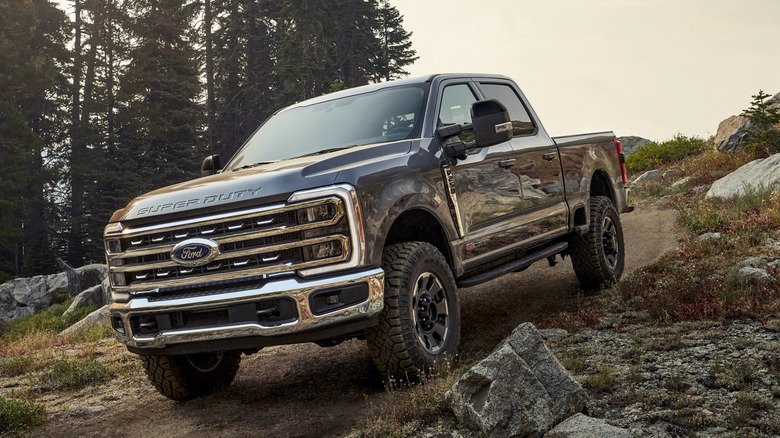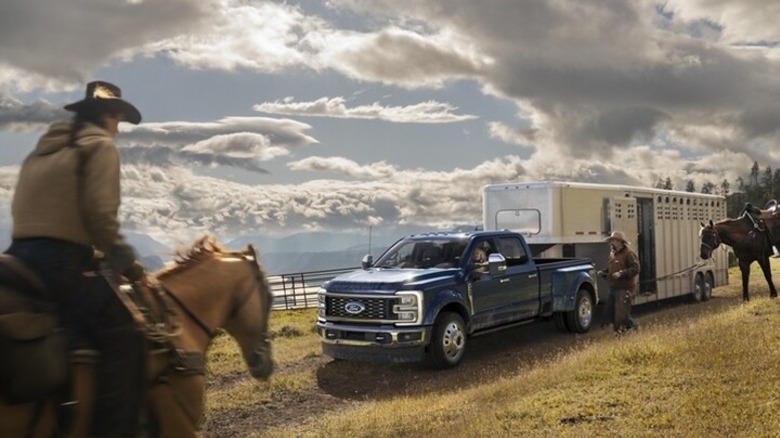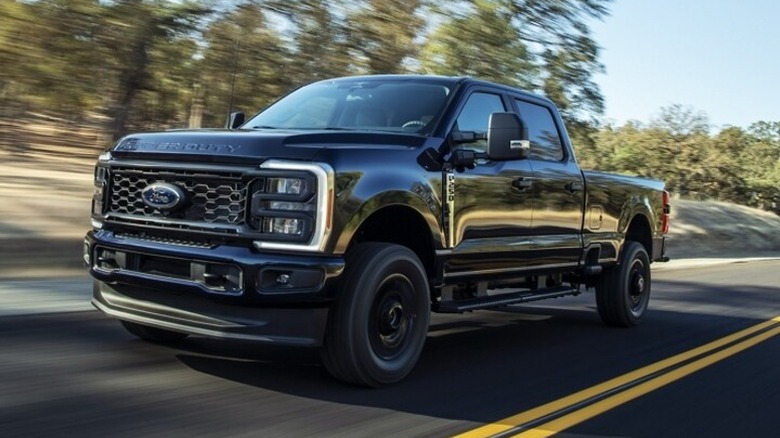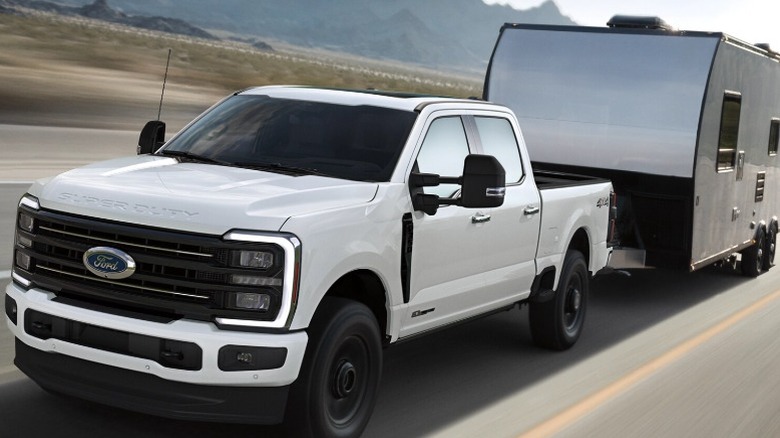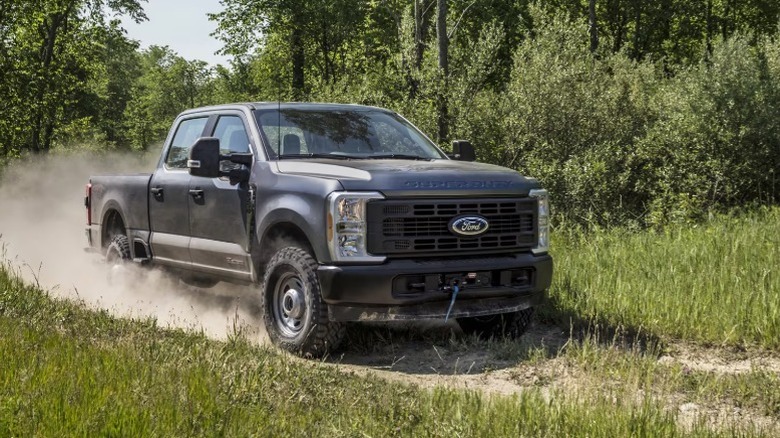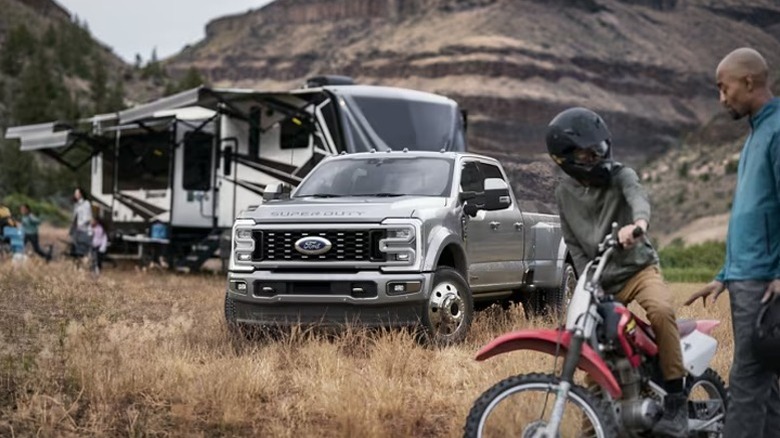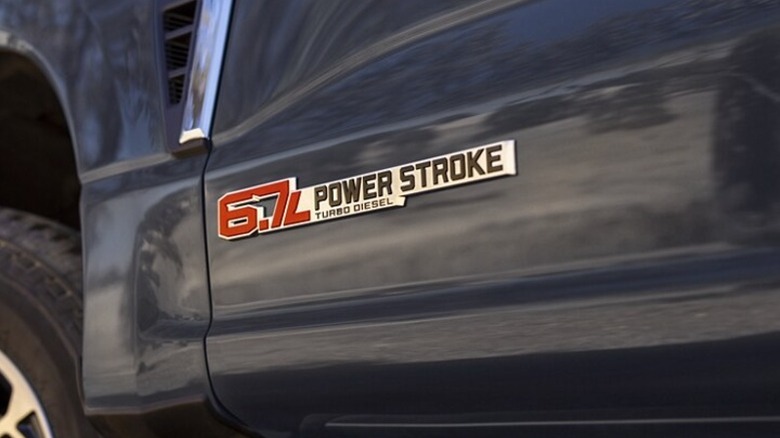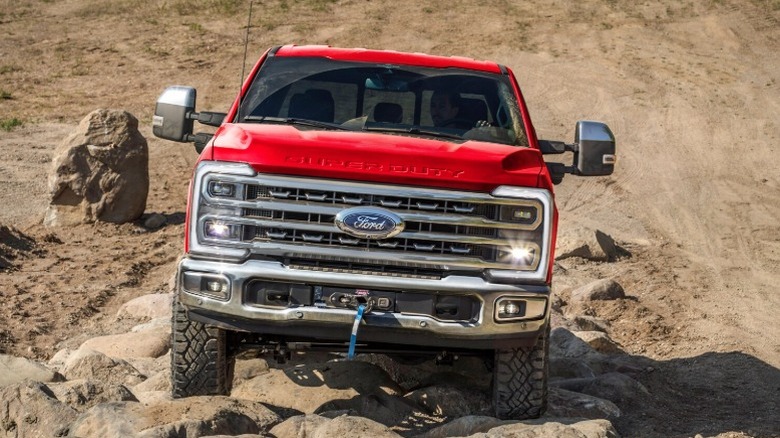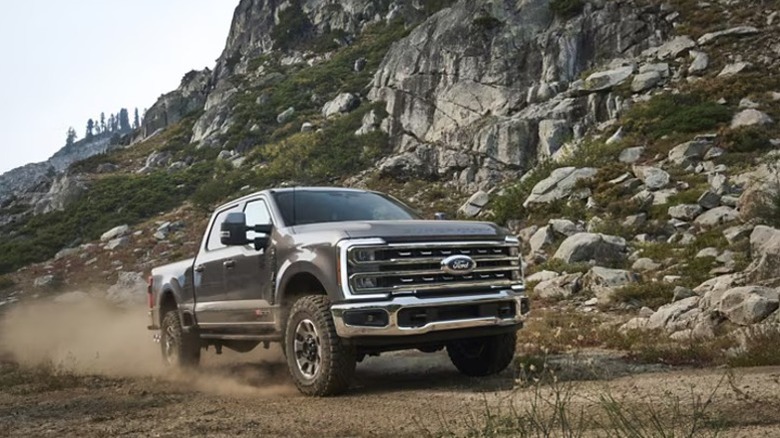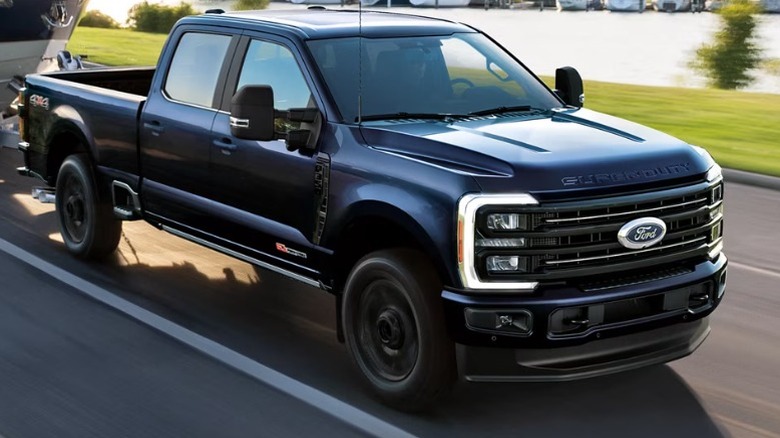9 Things To Know Before Buying A Used Ford Power Stroke Truck
The Power Stroke engine is undoubtedly one of Ford's most advanced and notable creations. Introduced in 1994, it has since featured in some of the company's most iconic and successful trucks. Ford primarily focused this engine on its Super Duty trucks, beginning this journey with the 7.3-liter engine. Quickly becoming a hit, this engine transformed the diesel truck industry and was widely recognized throughout its nine years of production. Since then, the company has rolled out the 6.0-liter Power Stroke in 2003, the 6.4-liter engine in 2007, and the current 6.7-liter Power Stroke engine that debuted in 2011.
Today, these Power Stroke engines are optional on Ford Super Duty trucks and chassis cabs, including the F-250, F-350, F-450, F-550, and F-600, as well as the F-650 and F-750 medium-duty trucks. They've also appeared in Ford Low Cab Forward models and E-Series vans and cutaways. Due to their reputation for performance, these trucks have long become a popular consideration among American truck enthusiasts, meaning there's a good chance they've been on your radar too. That said, here are nine things to know before buying a used Ford Power Stroke truck.
The 7.3-liter Power Stroke engine has some problematic years
The 7.3-liter Power Stroke was the very first Power Stroke engine introduced by Ford, and it was quite a marvel. This engine was in production from 1994 to 2003, powering Ford Super Duty trucks, the Ford E-series, and the Ford Excursion. To this day, it's known for its performance and prestige. However, if you're looking to buy one of these trucks, you'll need to watch out for some model years. They're known for a bunch of issues, from injector driver module contamination to loose UVCH connectors and camshaft position sensor failure. When it comes to the earliest model years, that is, those produced from 1994 to 1997, you might find issues with performance and horsepower output compared to later models. However, the 2001 to 2003 model years are generally considered to be the most problematic, with excessive engine noise and camshaft position sensor failure, which can pose problems when starting the vehicle.
The 1999 model year is likely your best bet for the 7.3-liter Power Stroke. For this model, updates were added, such as an enhanced cooler for the turbocharger, new transmissions, and larger injectors. It produced more horsepower than its predecessors and avoided many of the problems that the subsequent models became notorious for.
Find the trim that's right for you
Since 2011, the F-250, F-350, and F-450 have had the option of the 6.7-liter Power Stroke. However, apart from the various Super Duty offerings, Ford offers different trims for each model. This means you get to experience various upgrades and added perks as you move up the trim levels, but bear in mind that they also come at higher price points. The base trim is the XL. While it is a simple, budget-friendly option, it's also a rugged and reliable truck, great for individuals who need a functional vehicle. On the XLT, you get some extra tech features like pre-collision assist, a rearview camera, and blind spot monitoring.
Stepping up a notch, the Lariat trim offers not just added technology features like wireless charging and a 12-inch SYNC 4 touchscreen, but also Pro Trailer Backup Assist, making it ideal for buyers who prioritize towing and hauling. The King Ranch is similar to the Lariat but adds comfort touches like adaptive cruise control and Mesa brown leather seats. The Platinum trim offers more of a high-end driving experience, though not quite as luxurious as the Limited trim, which combines the best of power and technology. Whether your priority is luxury, utility, or affordability, there's a trim that fits the bill.
The F-450 has the best towing capacity
When it comes to vehicles that can handle a great deal of towing, particularly among non-commercial options, not many can compete with the Ford F-450. With three generations manufactured so far, it's one of the best trucks ever made for maximum towing capacity and also one of the biggest Ford trucks you can buy. On modern models, this truck offers both the 6.7-liter Power Stroke and the 6.7-liter High-Output Power Stroke turbo diesel V8 engine. Both of these engines offer a best-in-class conventional towing capacity of 30,000 pounds. For gooseneck towing, while the 6.7-liter Power Stroke achieves up to 38,600 pounds, the high-output engine can pull 40,000 pounds. Payload capacity reaches as high as 6,457 pounds.
For comparison, the F-350's maximum towing capacity is 27,000 pounds and 32,900 pounds max with a gooseneck trailer, while the F-250 has a maximum of 22,000 pounds for conventional towing and 23,000 pounds for gooseneck towing.
Watch out for reliability issues with the 6.0-liter Power Stroke
Ford released the 6.0-liter Power Stroke in 2003 to address concerns relating to its predecessor, the 7.3-liter engine, especially regarding emissions. However, even this upgrade had its own share of problems. So, in Ford trucks released from 2003 to 2007, you're likely to find problems like head gasket failure. This defect can cause engine overheating, failure of the vehicle to start, milky or frothy oil, and fluid leaks. Since this issue has been traced to the head bolt, replacing this component and other problematic parts of the engine is one way to prevent further damage.
Another common defect is with the EGR cooler. Due to the tendency of the oil cooler to clog with particles, the EGR coolers in these trucks do not receive enough coolant, and over time, the internal passageways can rupture. In addition, the 6.0-liter Power Stroke is known for injection system issues, including Fuel Injection Control Module (FICM) failure and high-pressure oil leaks. So, while trucks with this Power Stroke might be affordable, their problems can be a headache to deal with. They also contribute to its reputation for unreliability and low resale value.
The 2018 Ford F-150 3.0-liter Power Stroke has impressive fuel economy
Ford introduced the Power Stroke engine for the F-150 for the first time in 2018, and it met all expectations. With this turbo-diesel 3.0-liter V6, the company assured better fuel economy, efficiency, and smooth power delivery. Unfortunately, it only stuck around until 2021. This engine, which was created by Ford along with PSA Peugeot Citroën, delivered 250 horsepower coupled with 440 pound-feet of torque. Since it was an optional engine, it served owners who needed more torque to handle their towing needs. But where it stands out the most is fuel economy, boasting up to a 30-mpg highway EPA rating and 22 mpg in the city.
On top of that, the 3.0-liter power stroke is an impressively quiet engine, even for a diesel, and the performance is hard to complain about. However, due to price constraints, many buyers still opted for the EcoBoost V6 gasoline. And with Ford facing production issues at the time, the 3.0-liter engine was phased out. Even so, for a used model, this F-150 remains a worthy consideration.
Not all years for the 6.7-liter Power Stroke engine are great
Introduced back in 2011, the 6.7-liter is Ford's most recent Power Stroke engine. It was an improvement over its predecessors in many aspects. However, the quality and performance of different model years are not the same. The first generation, produced from 2011 to 2014, has become notorious for some recurring problems. One of these is coolant leaks, largely due to the build-up of soot in the EGR valve, which may decrease fuel efficiency, increase emissions, and cause poor acceleration. While in some cases this may be solved by cleaning the valve, more severe instances might require a complete cooler replacement. You're also likely to find some sensor issues in this generation.
The biggest headache for many owners, however, is the failure of the injection pump, which is often detected through engine noise, low power output, and poor mileage. Because of how badly it can affect the fuel system, fixing this issue is often very expensive, and it has been found even in second-generation models. Thankfully, Ford resolved a number of these issues in subsequent model years. Advancements in the Power Stroke are evident in the third and even the second generation, so you're less likely to encounter major problems in those trucks.
For off-roading, get the F-250 Tremor
While the Power Stroke engine offers excellent performance, off-roading requires some extra features beyond what you get on a regular vehicle. Ford first used the Tremor name back in 2002 as an option package on the Ranger. This nameplate is featured on the Ford Ranger, but it also appears on the Ford F-150 as a trim. The Tremor was added to the Super Duty more recently, introduced as an off-roading package on the F-250 in 2020. However, it was only made available on specific trims, namely, the XLT, King Ranch, Lariat, and Platinum, and only those that came with the four-door crew-cab body style. For the 2024 model, it became available on Ford F-350 trims as well.
With this package, Ford adds extra ground clearance along with a lockable rear differential, skid plates, off-road tuned suspension, and a limited-slip front differential. This is coupled with assistive features like Trail Turn Assist and the Trail Control drive mode. Of course, these perks come at the cost of a few thousand dollars, but if you're looking to take your Power Stroke truck down the beaten path, you'll need a model that's built for the task.
The F-600 offers more weight capacity than the F-550
When thinking of Ford heavy-duty trucks, the F-550 and F-600 come to mind. Both options come with Power Stroke engines and pack sufficient power, durability, and versatility. However, when it boils down to picking one of the two for heavy-duty tasks, the F-600 may be the better choice. The difference between these two trucks is not immediately apparent. They share most of the same external features, and under the hood, you get a 7.3-liter 2V DECVT V8 gas engine by default, with the option of the 6.7-liter Power Stroke.
However, when you look at the gross vehicle weight rating (GVWR), gooseneck towing, and maximum payload, the F-600 clearly outperforms the F-550. While the F-550 has a maximum payload of 12,770 pounds, the F-600 reaches 15,210 pounds. For gooseneck towing, you can get as much as 34,500 pounds on the F-550 and 34,900 pounds on the F-600. GVWR ratings sit at 22,000 pounds for the F-600, while the F-550 gets 19,500 pounds. Ultimately, the F-600 is essentially an F-550 with additional power, and Ford achieved this through 19.5-inch tires with higher weight ratings and by making improvements to the brake system, driveline, and chassis.
The 6.4-liter engine has oil dilution and radiator leak issues
The 6.4-liter Power Stroke engine succeeded the 6.0-liter Power Stroke in 2007. With its introduction came expectations that it would make up for the shortcomings of its predecessor. However, it didn't stick around for long, as Ford replaced it only two years later, a major reason being its numerous reliability concerns. The radiator leak is one of its most commonly reported issues. This problem causes the engine to overheat and is often only effectively remedied by replacing the radiator with a better-quality option. In addition, it was notorious for having residual fuel seeping into the oil system. Known as oil dilution, this defect can put the engine at risk of severe internal damage, as it prevents engine parts from getting adequate lubrication.
Several other complaints, like cracked exhaust pipes, EGR system failure, and cracked pistons, are also quite frequent with this engine. On top of all that, fuel economy is particularly unimpressive, so it's no surprise that it didn't last very long in production.
